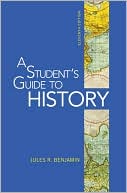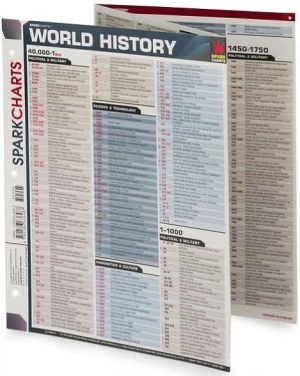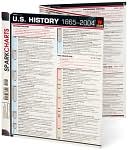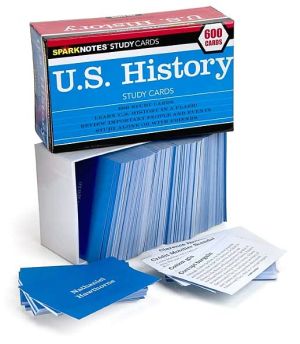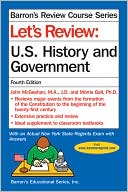A Student's Guide to History
Search in google:
A Student’s Guide to History provides the practical help students need to be effective in their history courses. In addition to introducing students to the nature of the discipline, it teaches a wide range of skills from preparing for exams to approaching common writing assignments, and it explains the research and documentation process using numerous examples throughout. With clear and accessible advice, A Student’s Guide to History is an indispensable resource for history students. New, easy-to-reference chapter organization. Shorter, more manageable chapters now focus on more specific concepts, such as building a history essay and documenting sources, so students can more easily find the information they need. Expanded coverage of working with sources. A new chapter explains how to examine any source of historical evidence — primary or secondary, written or nonwritten, print or digital. New Guidelines boxes for evaluating primary sources, a new section on sound and video recordings, new warnings about Wikipedia, and more on finding primary sources online equip students to engage in a wide range of historical work. More attention to analysis and argument. New sample writing assignments demonstrate how to analyze and compare primary and secondary sources and present theses with supporting evidence. The research chapters now offer more advice on developing a thesis, using evidence, formulating worthwhile research questions, and writing more persuasive papers. New visual citation guidelines boxes annotate sample pages from books, published letters, print articles, database articles, and Web sites, and key them to model notes and bibliographic entries to show students how to find publication information and properly cite these common sources.
Preface vA Note to Students xvii1 The Subject of History and How to Use It 1What History Can Tell You 1What Historians Are Trying to Do 3History and the Everyday World 4How Historians Work 4Philosophies of History 5Historiography 6Changing Directions of Historical Research 8Methods of Historical Research 9Primary and Secondary Sources of Evidence 10Interpreting and Organizing Evidence 16The Computer and Historical Research 16How You Can Use History 172 How to Read a History Assignment, Take Notes in Class, and Prepare for and Take Exams 19How to Read a History Assignment 19Reading a Textbook 20Reading a Monograph 20Reading an Anthology 22Reading a Historical Novel 22Examples of Reading Assignments 22How to "Read" Nonwritten Materials 25Interpreting Maps 26Analyzing Statistical Data 28Interpreting Illustrations, Photographs, and Other Visual Material 31Interpreting Artifacts 34How to Take Notes in Class 37From Class Lectures 37Guidelines for Taking Lecture Notes 38Examples of Note Taking 38From Slides and Films 42Taking Notes in a "Wired" Classroom 42Classroom Participation 43Classroom Discussions 43Guidelines for Speaking in Class 43Giving an Oral Presentation 43Guidelines for Giving an Oral Presentation 44Giving a PowerPoint Presentation 44Group Work 45Guidelines for Peer Reviewing 46Communicating Online 46E-mail, Listservs, and Chat Rooms 47E-conferences and E-seminars 48Web Communication and Advanced Research 48How to Study for and Take Exams 49Objective and Short-Answer Exams 50Preparing for In-Class Essay Exams - Composing Sample Questions51Writing a Good In-Class Essay Exam 52Guidelines for Writing In-Class Essay Exams 52Writing Take-Home Essay Exams 533 How to Write History Assignments: The Importance of Writing Skills 57Why Clear Writing Is Important 57The Components of Clear Writing 58Write Clear Sentences 58Do Not Clutter Sentences with Unnecessary Phrases 58Avoid Using the Passive Voice 59Use the Past Tense 59Link Your Sentences 60Write Clear and Coherent Paragraphs 60Link Your Paragraphs 61Guidelines for Clear Writing 62Building an Essay 62The Need for a Clear Beginning 63Creating a Writing Outline 64The Importance of Continuity 64Writing a Conclusion 65Revising Your Paper 65Proofreading Your Paper 66Preparing Specific Writing Assignments 67Writing Book Reviews 67Sample Book Review 68Guidelines for Writing a Book Review 71Writing Comparative Book Reviews 71Comparing Essays or Articles 72Comparing Primary Documents 72Writing Short Essays 73Guidelines for Writing Short Essays 74A Note on Plagiarism: A Serious Offense 754 How to Research a History Topic 77Beginning the Research Process 78Choosing a Topic 78Moving from a Topic to a Theme 78Narrowing Your Theme 79Moving from a Theme to a Thesis 80Making an Argument in Support of Your Thesis 81Creating a Preliminary Research Plan 81Creating a Research Bibliography 83Conducting Research 84Using the Library Online Catalog to Locate Resources 84Using Print and Electronic Reference Sources 88Using Print and Electronic Periodical Databases 89Guidelines for Finding an Article in a Periodical Database 90Locating Primary Sources 92Using Internet Search Tools 95Guidelines for Conducting Internet Searches 97Evaluating Web Sites 97Guidelines for Evaluating Web Sites 99Navigating Web Sites 99Evaluating Sources 100Evaluating Secondary Sources 101Guidelines for Evaluating Secondary Sources 102Evaluating Primary Sources 103Special Problems of Evaluating Web-Based Sources 105Guidelines for Evaluating Web Sources 106Interpreting Sources and Taking Notes 107How to Read Your Sources 107How to Record Information from Your Sources 108How to Organize Your Notes 110Avoiding Plagiarism 115The Computer and Plagiarism 116The Art of Paraphrasing 116Plagiarism and Group Work 117Guidelines for Avoiding Plagiarism 1185 How to Write a Research Paper 119Preparing to Write 119Why Your Paper Needs a Thesis 119Organizing Your Paper 120Preparing a Writing Outline 120Plugging Your Research Notes into Your Outline 124Writing the Text 125The Rough Draft 125Clear Writing: A Matter of Continuity 126Quotations: When and How to Use Them 127Incorporating Visual Materials into Your Paper 129Guidelines for Incorporating Visuals 130Documenting Your Paper: Citing Your Sources 130When and How to Use Footnotes and Endnotes 130Directory to Footnote/Endnote Documentation Models 132How to Write Footnotes and Endnotes 133Directory to Bibliography Documentation Models 146Organizing a Bibliography 147Revising and Rewriting 158Guidelines for Revising and Rewriting 159Word Processing: Advantages and Dangers 160Example of a Research Paper 161How the Theme and Thesis Were Chosen 162The Writing Outline for the Thesis 162Turning Research into Writing: A Sample Research Paper -"Wage Slavery or True Independence: Women Workers in the Lowell, Massachusetts, Textile Mills, 1820-1850" 164Appendix A Resources for History Research 185Dictionaries, Encyclopedias, and Atlases 186Historical Dictionaries-World 187Historical Dictionaries-United States 188Historical Encyclopedias-World 188Historical Encyclopedias-Europe 189Historical Encyclopedias-United States 190Historical Atlases-World 190Historical Atlases-United States 191Biography Collections 191International Biography Collections 192United States Biography Collections 192Newspaper Indexes and Databases 193Newspaper Indexes and Databases-General 194Newspaper Indexes and Databases-United States 194Periodical Indexes and Databases 195Magazine Indexes and Databases 195Journal Indexes and Databases 196Book Review Indexes and Databases 197Public Documents 197Public Documents-Britain and Canada 198Public Documents-United States 198Historical Statistics 199Historical Statistics-General 200Historical Statistics-National and Regional 200Historical Statistics-United States 201General Resources in World History 202Reference Works and Bibliographies 202Web Sites 203Specialized Resources in World History 204Ancient History 205Europe-General 206Europe-Medieval 207Europe-Early Modern 208Europe-Modern 208Britain 210Ireland and Scotland 213East Europe 214Russia and the Soviet Union 215Africa 215Middle East and North Africa 216Asia 217Australia and New Zealand 220Latin America and the Caribbean 220Canada 221General Resources in United States History 223Reference Works and Bibliographies 223Web Sites 224Specialized Resources in United States History 225Regional, State, and Local 226Colonial, Revolutionary, and Early National, 1607-1800 227Native American 228Slavery and the Civil War 229African American 231Women's 232Immigrant and Ethnic 233Social and Cultural 234Political 237Foreign Relations and International 239Science, Technology, Environment, and Medicine 240Labor, Business, Economic, and Urban 241Religious 242Military 242Electronic Discussion Lists in History 243Appendix B Historical Sources in Your Own Backyard 245How to Research Your Family History 246Sources for County and Local History 247Sources for Family History and Genealogical Research 248Glossary 250Index 257
